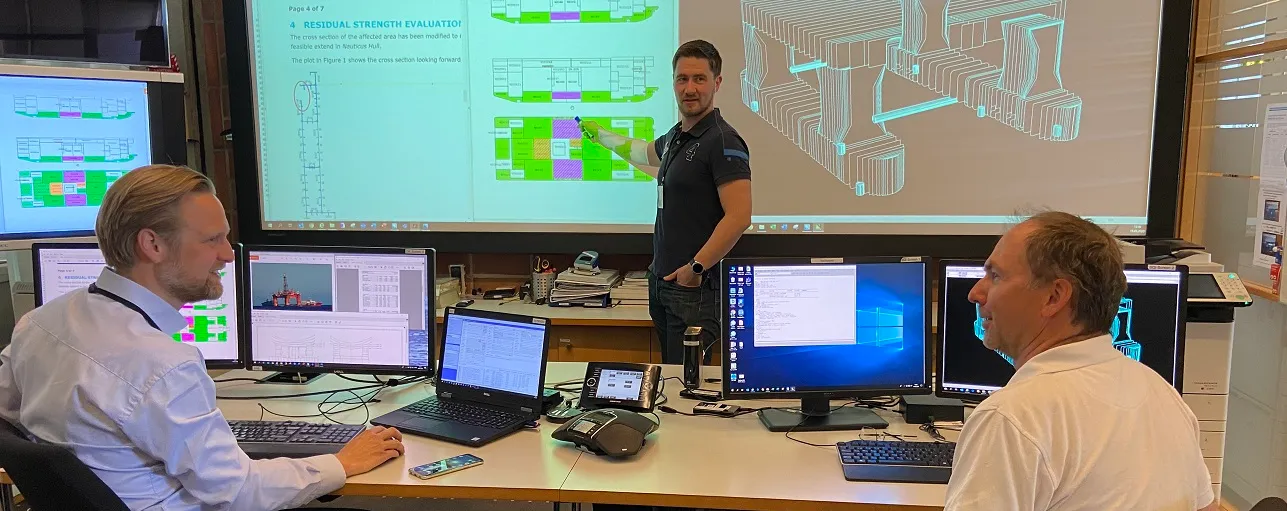"Yes, my pulse increases then. Suddenly, we have to drop everything and get to the office immediately. When customers call in such cases, they really need help," says Stokke.
The Emergency Response Service is DNV's own "emergency response centre". Those who are on standby duty must be ready to drop everything and provide assistance. When the phone rings, assets worth a lot of money are usually at risk.
"If a ship is grounded, it's the captain who has the overall responsibility, but he does not necessarily right there and then have all the information he needs to make the right decision. Our task is to calculate the ship's stability and structural strength and provide the captain with various scenarios. Then we have to give concrete advice on further measures. Our advice has to be given quickly, since we rarely have any time to lose in these situations," says Stokke.
He says the standby duty periods are both exciting and professionally challenging. "You never want the emergency phone to ring since that means something has gone wrong. If a ship is grounded, for example, then human lives, property or the environment are probably in danger. During such a real event, there is a certain level of stress and our expertise is really put to the test."
An exciting workday
DNV's Emergency Response Service (ERS™) offers expert help to assess the damage stability and residual strength of ships and offshore units that are in an emergency situation in which their stability, strength and seaworthiness are weakened. The dedicated standby team is available 24/7 to more than 4,300 ships and rigs that subscribe to this emergency service.
The service is involved in 20-30 accidents each year. They also hold drills during the weeks when no emergencies have arisen.
"We actually function as an emergency service and have to be prepared accordingly. For that reason, we hold regular drills so that we're as prepared as possible when real events take place."
An event for which the team practises a lot is a collision between a supply boat and a rig.
"What would such a 'turnout' look like?"
"As soon as the crisis team on board the rig contacts us, we know we're probably dealing with water ingress or some other significant damage. While our duty responsible asks the captain on board a number of questions, the rest of the ERS team are activated."
Truls Richardsen, duty responsible in DNV's Emergency Response Service. PHOTO: DNV
That is when the race against the clock starts.
"Whatever the time of day, we just have to stop doing whatever we're doing and get to the office. We know that our response time can be critical when handling an accident, so we try to get to our places, obtain an overview of the incident and start our calculations as quickly as possible. Normally, we manage to have the team in place within an hour of the first phone call," says Richardsen.
His task in this internal emergency service is primarily to function as the offshore expert, but recently he has been trained to be a duty responsible.
"That means my task is to be the point of contact between the rig and those of us in the control room," he says.
Once the team is in place in the control room, they start on their calculations. They have models of all the ships and rigs that subscribe to the service in their system so they can start work quickly. They all know the order of priority of the tasks to be carried out.
"First and foremost, we have to save human lives. Our initial calculations are to discover whether there is any danger to the people on board the ship or rig. Then we give the captain advice based on our findings," says Richardsen.
As soon as human life is safeguarded, they start on new calculations.
"Secondly, material assets and the environment must be safeguarded. For example, we have to calculate our opportunities to stabilize the rig on an even keel by moving onboard fluids around, and whether we can move the rig to a suitable shipyard even though it's listing," he says.
This work can take anything from a few hours to several days.
"So we also have a backup team and backup room. If several incidents occur at the same time, we have the capacity to deal with them all."
– Never a dull moment
Richardsen says it is the varied mix of tasks that motivates him to get up and go to work each morning.
"The job is so varied that you never get bored. We can have a week in the office doing technical and administrative tasks. Suddenly, we're faced with critical
ERS™ challenges in connection with an emergency salvage operation. Then we can have a week going round visiting rigs and talking to fantastic people with different backgrounds. It's quite simply a wonderful job," he says.
